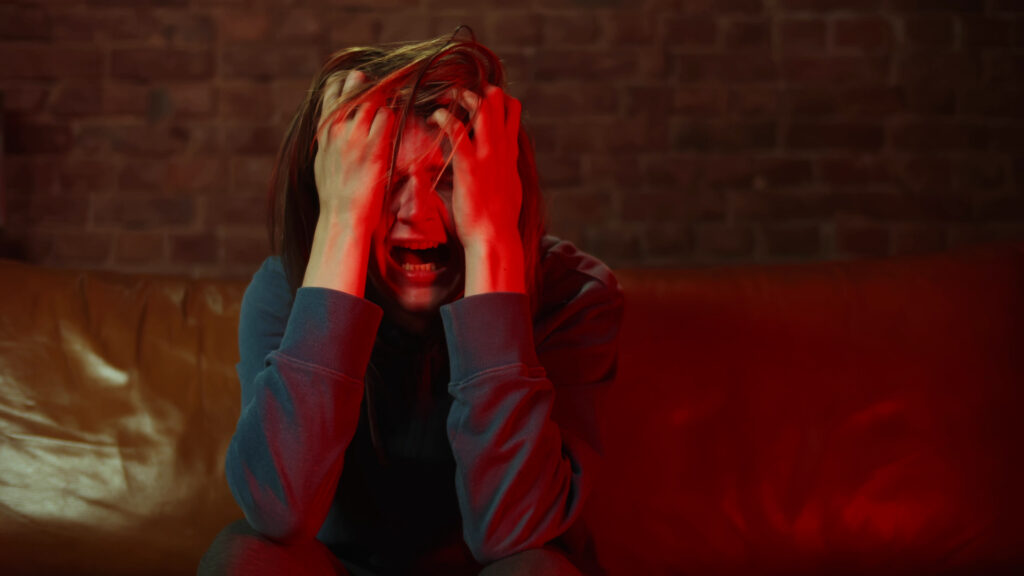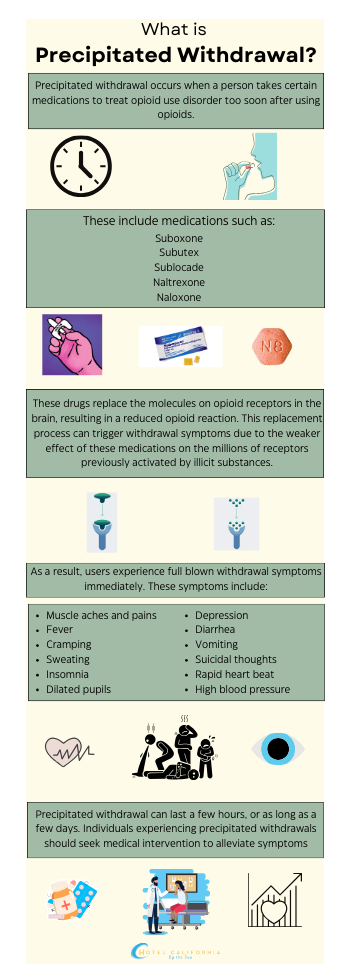What is Precipitated Withdrawal?
Precipitated withdrawal is the sudden occurrence of withdrawal symptoms that have been brought on by the use of medications such as buprenorphine or naltrexone. It is the rapid onset of withdrawal symptoms that develop when a person takes medications before opioids are fully removed from their system. In comparison to substance withdrawal, precipitated withdrawal is caused by the use of medications and not the deprivation or abstinence of an addictive substance. Withdrawal symptoms such as fever, cramping and sweating can be triggered when medications to reverse opioid effects are actively used in combination with active opioid use. The immediate reaction is usually mild and brief but can also be sudden and even severe.

A 2010 study found that precipitated withdrawal occurred in around 9% of users who took buprenorphine to manage opioid use disorder. In a 2021 case study, research found precipitated withdrawal could begin as soon as 1-2 hours after a patient received opioid treatment medication. During the detox phase or recovery, commonly used medication-assisted treatments (MAT) such as naltrexone, naloxone, suboxone, sublocade, vivitrol and other buprenorphine medications can help reverse opioid overdose effects. These medications can also trigger the onset of precipitated withdrawal if not used correctly. The majority of the time, precipitated withdrawal is an unintentional side effect of opioid use disorder treatment.
Precipitated Withdrawal vs Substance Withdrawal
Typical substance withdrawal occurs gradually while precipitated withdrawal occurs very suddenly. Substance withdrawal is due to the deprivation of an addictive substance. When someone has become dependent on a substance his or her brain and body becomes physically dependent on the drug. When there is a sudden decrease or abrupt cessation of the drug, the body can be thrown off as it rushes to try and rebalance itself causing the onset of withdrawal symptoms. Substance withdrawal also tends to last much longer than precipitated withdrawal.
In people who are physically dependent on opioids, the sudden loss of signals from opioid receptors can trigger symptoms of precipitated withdrawal. This occurs when the user still has opioids within their system and medications are taken to reverse these symptoms. The body can go into shock and sudden withdrawal occurs. In a situation in which a person might be overdosing on opioids, when they are given the emergency medication naloxone, a single dose is high enough to cause a sudden and often times painful experience of withdrawal.

Medications used to treat Opioid Use Disorder that can trigger Precipitated Withdrawal
- Naltrexone (Vivitrol) – Naltrexone is used to block feelings of euphoria from alcohol use and opioid use. It is an opioid antagonist and is taken on a regular basis to prevent euphoria in the event of a drug relapse. When taking this medication, the patient must be completely free of opioids in order to avoid the onset of precipitated withdrawal.
- Naloxone – Naloxone is referred to as an emergency medication and is given to prevent opioid overdose by reversing the effects of opioids. It is an opioid antagonist that works by binding to the opioid receptors in the brain and blocking the effects that opioids produce.
- Methadone – Methadone is used to reduce opioid cravings.
- Buprenorphine – Buprenorphine is used to reduce and suppress opioid effects and cravings. It is an opioid antagonist and works by blocking opioid receptors in the body from receiving reward signals from the opioids in your system. It occupies the mu receptors in the brain but does not activate them. They block the effects of other opioids including the opioids that are already present in the person’s body. In a person who has become dependent on opioids, the sudden loss of the effects from those opioids can trigger precipitated withdrawal.
- Suboxone and Sublocade – Both of these types of buprenorphine medications are partial opioid agonists and work by displacing opioids such as heroin and fentanyl and preventing them from binding to the opioid receptors in the brain. Partial agonists work by partially activating and stimulating the mu receptors in the brain.
During the detox phase of drug addiction treatment, many patients use MAT to help alleviate the uncomfortable symptoms of substance withdrawal. It is a commonly used treatment method and has been proven effective and life-saving for many patients. It is used in treatment for opioid use disorder as well as other types of alcohol and substance use disorders. One of the biggest side effects of MAT is the occurrence of precipitated withdrawal.
Check Your Insurance Coverage for FREE
Find out if your insurance covers addiction treatment in minutes. We accept most insurance!
Symptoms of Precipitated Withdrawal
- Difficulty sleeping and developing sleep issues such as insomnia
- Excessive sweating
- Fever/high body temperature
- Agitation and restlessness
- Anxiety
- Nausea and vomiting
- Runny nose
- Chills and Goosebumps
- Headache
- Dilated pupils and watery eyes
- Muscle aches and cramps
- High blood pressure
- Heart palpitations
- Diarrhea
Precipitated withdrawal symptoms can begin as soon as an hour or two after the first dose of buprenorphine or other opioid reversal medications have been administered. The duration can be anywhere from 6-24 hours. Factors that affect the duration of withdrawal include the severity of the dependence on opioids, previous withdrawal experiences, the specific medication that was taken to induce withdrawals, the dose of the medication and other types of treatments and support.
How to cope with Precipitated Withdrawal
The best way to stop precipitated withdrawal from happening is prevention. A person must be completely cleared of opioids from their system before continuing with medications such as buprenorphine or naltrexone. Professional substance addiction treatment programs can help to make sure patients are receiving the appropriate medications at the appropriate times in order to avoid precipitated withdrawal. If it does happen, patients will have to endure uncomfortable symptoms that can be short-lived. Drinking lots of water, reducing stress and treating symptoms as they occur can help during the withdrawal process.
Reach out to Hotel California by the Sea
We specialize in treating addiction and other co-occurring disorders, such as PTSD. Our Admissions specialists are available to walk you through the best options for treating your addiction.
Treatment for Opioid Use Disorder
Precipitated withdrawal occurs when a person dependent on opioids develops sudden withdrawal symptoms brought on by the effects of opioid use disorder medications such as buprenorphine or naltrexone. These types of medications are commonly used during detox in medication-assisted treatments. They force the body to stop depending on opioids and if the body has not been completely rid of the substance when taking these medications, you can experience precipitated withdrawal.
Opioid antagonist medications such as buprenorphine are crucial to treatment but need to be taken at the right time and in the correct way in order to avoid symptoms of precipitated withdrawal. The medications immediately block the brain from the opioid effects and can send the body into withdrawal. Hotel California by the Sea provides the highest quality of care when it comes to effectively treating opioid use disorder. Our detox program provides medication-assisted treatments, medication management and rigorous medical assessment during this vulnerable stage of recovery. We also offer residential and outpatient programs for continuing treatment and patient support.
We utilize evidence-based treatment methods such as CBT, DBT and group therapy. We also offer various social services, access to vocational education and assistance in aftercare planning. These are essential for clients as they slowly ease out of full-time treatment and into independent living. Hotel California by the Sea understands the difficulties of an opioid addiction. We provide care to clients at all levels of treatment to help them overcome their addictions.
References:
https://www.verywellmind.com/precipitated-withdrawal-definition-symptoms-traits-causes-7089732
https://www.healthline.com/health/opioid-withdrawal/precipitated-withdrawal
https://www.naabt.org/documents/NAABT_PrecipWD_HiRes.pdf
https://ophelia.com/blog/what-is-precipitated-withdrawal
https://www.ncbi.nlm.nih.gov/pmc/articles/PMC10162012
https://www.medicalnewstoday.com/articles/precipitated-withdrawal
https://www.bicyclehealth.com/opioid-education/precipitated-withdrawal
